After Jonathan Toews and Patrick Kane inked matching $84 million dollar extensions last month, some pundits seemed ready to anoint them as the NHL’s top forward pairing:
Jonathan Toews & Patrick Kane are staying with #Blackhawks until 2022-23… and 29 other teams & their fan bases are jealous.
— Pete Jensen 🏒 (@NHLJensen) July 9, 2014
I’m guessing most Pittsburgh Penguins or Los Angeles Kings fans weren’t the least bit envious. That’s not a shot at Chicago’s “Odd Couple”—they’re terrific—but they aren’t head and shoulders above the rest of their peers. Even their chief accomplishment, two Stanley Cup rings, has just been matched by Anze Kopitar and Jeff Carter.
So Who Are the NHL’s Most Dynamic Duo?
Let’s try to answer that question by examining Contracts, Points/60 Minutes, Usage, and dCorsi for 10 elite attacking pairs.
Warning: This article is only exploring forward one-two punches; they needn’t be regular linemates.
Before we proceed, let’s talk omissions…like where are Tyler Seguin-Jamie Benn and John Tavares-Kyle Okposo? I concentrated on teammates who have flourished together for longer. Claude Giroux-Jakub Voracek have a real case, but for whatever reason, Voracek’s Average Time on Ice over the last two campaigns was lower than expected. Steven Stamkos needs a running mate; Taylor Hall-Jordan Eberle need the playoffs. Henrik Sedin-Daniel Sedin suffered a catastrophic season, but with lowered shot blocking expectations, perhaps they’ll bounce back.
Contracts
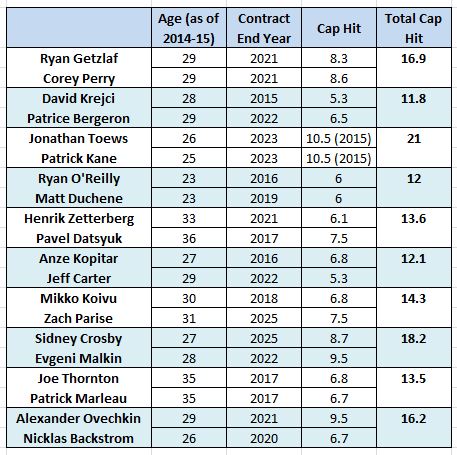
So which combination’s age/cap hit is optimal now…or in three years? Looking ahead to 2016: How much has the Colorado Avalanche alienated O’Reilly? Will Kopitar clear 10 million?
Toews and Kane are the salary cap era’s first 10 million dollar men. Certainly not the last, they may count as underpaid soon enough. Using James Mirtle’s formula, a $4 billion revenue projection in 2014-15, and an annual 5% revenue increase thereafter, a salary cap around $100 million seems possible by the end of the current CBA (this is not accounting for escrow):
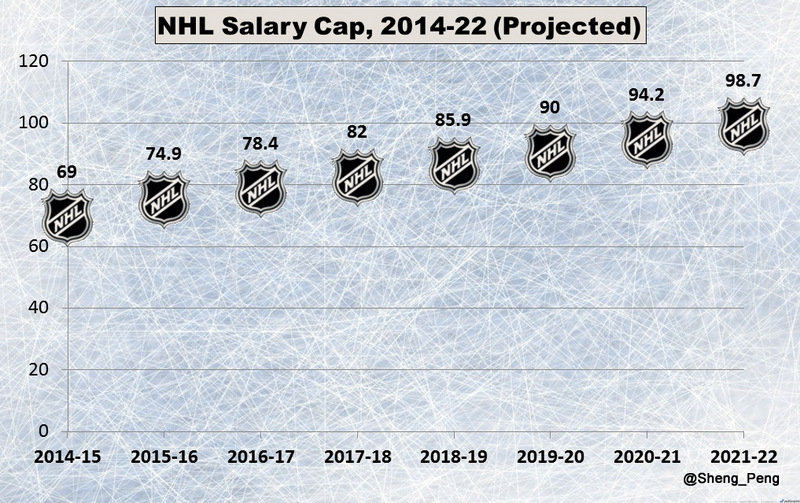
Do Getzlaf-Perry or Crosby-Malkin look that expensive anymore? Also, consider that even after Kopitar re-ups, he and Carter may still cost less than Ovechkin-Backstrom!
5v5 Points/60
What’s the average 5v5 scoring rate of an NHL first-line forward?
https://twitter.com/garrethohl/statuses/485440061593227265
To be more exact:
https://twitter.com/garrethohl/status/485442771767918592
Let’s take a look at our “cream of the crop” combos:
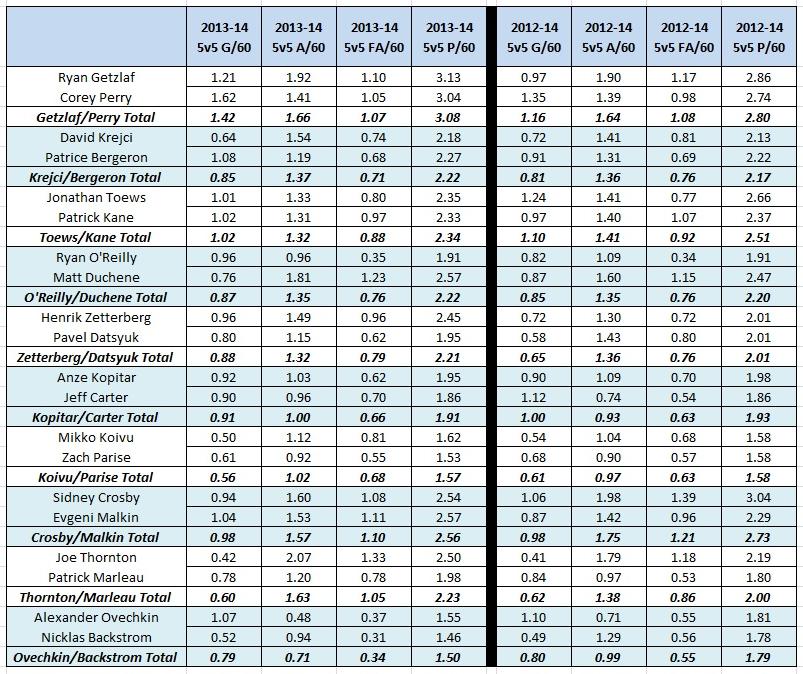
Getzlaf-Perry fly together here, individually ranking third and fourth in 5v5 Points/60 from 2012-14 (over 1500 mins). You won’t be shocked by who’s on first.
In that period of time, Perry breaks away from the flock with the second-most 5v5 Goals/60 (following Rick Nash). Toews and Carter also appear in the top 10.
Crosby marches right by the competition in 5v5 First Assists/60. Thornton, Getzlaf, and Duchene follow, well behind.
Despite their contrasting reputations, Toews (2.6) has actually outpointed Kane (2.33) at 5v5/60 over the last three seasons. Of course, Toews didn’t see Michal Handzus on his line much.
Can the aging Detroit and San Jose stars stave off the Career Reaper in 2014-15? Both Thornton (1.67 5v5 Points/60) and Zetterberg (1.55 5v5 Points/60) rebounded from a tough 2012-13 with a 2.5 and 2.45 respectively.
Koivu has eked out a pedestrian 1.48 5v5 Points/60 from 2011-14, but we’re about to get to the reasons why he’s in our VIP.
Ovechkin has become more and more dependent on the power play for production, wringing a 1.77 5v5 Points/60 from 2011-14; from 2007-11, he averaged almost a full point more (2.72). As his regular center for the past six years, Backstrom’s stats were certainly affected.
5v4 Points/60
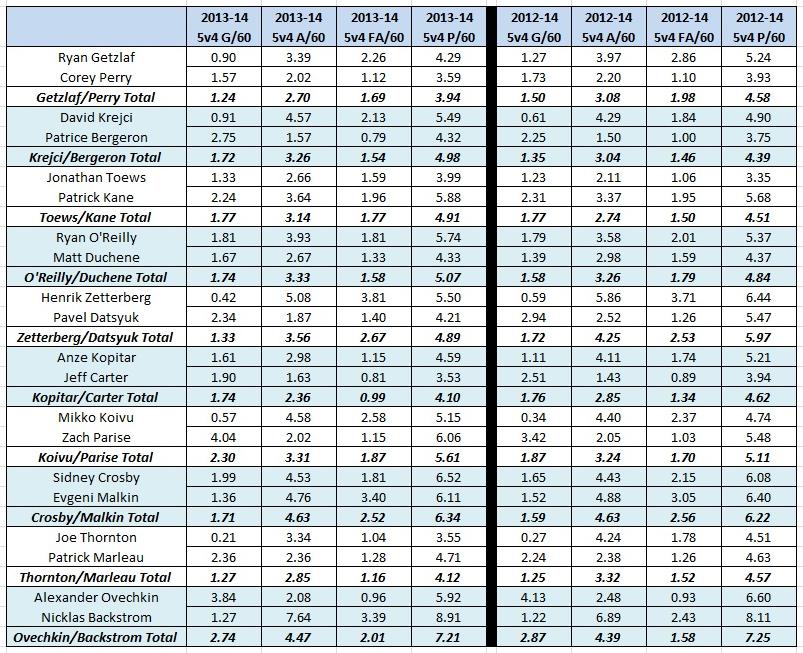
Saying that Ovechkin-Backstrom made up for their 5v5 shortfall on the power play is an understatement. From 2012-14, Backstrom paced the league in 5v4 Points/60 (over 300 mins) by nearly a point (8.11); Giroux (7.14), Ovechkin (6.6), Zetterberg (6.44), and Malkin (6.4) round out the leaderboard, while Crosby (6.08) and Kane (5.68) also make the top 10.
Of course, Ovechkin tops the league in 5v4 Goals/60 (4.13). Parise follows (3.42) and Carter cracks the top 10 (2.51).
Close at even strength, Crosby-Malkin distance themselves from Getzlaf-Perry on the power play.
Usage
By and large, these are the forwards who eat up most of their team’s even strength minutes.
It’s assumed that first-line forwards will get the lion’s share of their squad’s time on the man advantage. However, only a select few also earn enough trust from the coaching staff to tough out shorthanded minutes.
So relative to all teammates, how are our premier pairings being deployed on the power play and penalty kill?
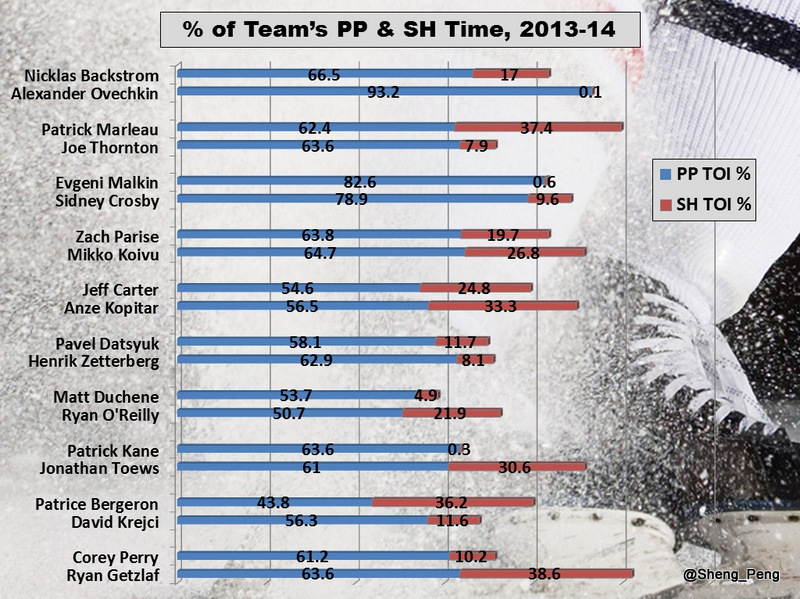
While trust doesn’t necessarily equate results—Getzlaf, Kopitar, Koivu, and Marleau own relatively weak 4v5 shot suppression totals—the players who get little to zero PK time stick out.
Note that the only complete tandems who play both heavy power play and penalty kill minutes are Kopitar-Carter and Koivu-Parise.
Ovechkin eats up an astounding amount of Washington’s power play time.
dCorsi
dCorsi stands for “delta Corsi.” It strives to measure an individual’s Observed Corsi VS his Expected Corsi.
Unlike the much simpler Corsi (shot attempts for VS shot attempts against), dCorsi also accounts for 5v5 quality of competition, Corsi relative to team, faceoffs, zone starts, player usage, and even age, among other things.
At least dCorsi results are straightforward—positive (in blue) is good and negative (in red) is bad.
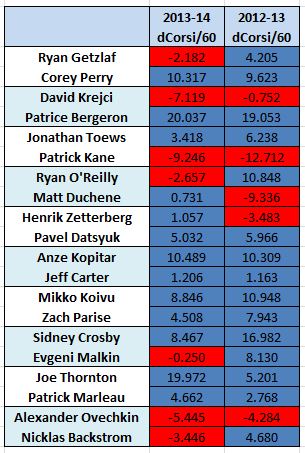
dCorsi shortchanges Kane and Ovechkin. In 2013-14, Bergeron and Thornton’s figures led the league; in 2012-13, Bergeron was third and Crosby fifth.
It’s worth noting that Kopitar-Carter, Koivu-Parise, and Thornton-Marleau have achieved positive dCorsi ratings throughout the last two years.
Conclusion?
There’s no cut-and-dry answer.
Kopitar-Carter’s current 12.1 million combined cap hit is a steal (Toews-Kane’s 12.6 isn’t shabby either). Because of Carter’s low long-term cap hit, Kopitar-Carter should retain solid value for many years.
The most reliable scoring duo are probably Crosby-Malkin; their excellent 5v5 and 5v4 Points/60 showings give them an edge over the underrated Getzlaf-Perry.
However, strictly on the man advantage, Backstrom to Ovechkin is the stuff of nightmares.
Kopitar-Carter have a solid case for being the best two-way combo in the league; their PK responsibilities speak to their overall defensive prowess. Koivu-Parise are decent on both sides of the puck, especially on special teams, but their 5v5 production is wanting. Viewing Koivu as a poor man’s Kopitar doesn’t seem a stretch.
And since Toews and Kane’s extensions spurred this conversation, it must be said: Offensive wizard that he is, Kane is lucky to be making as much money as his captain.
Your Dream Team?
Imagine starting a team with any two NHL forwards.
Consider all the factors that we’ve already discussed—age, contracts, production, usage, and dCorsi. Who would you pick?
I already consider Crosby and Bergeron to be relative bargains right now. And while both come with red flags because of past injuries, how can you resist the gamble of matching the world’s finest offensive machine with its leading defensive forward? Especially at a cap hit of just 15.2 million through 2022?
Stats courtesy of Behind the Net, Extra Skater, Hockey Analysis, Hockey Reference, @MimicoHero, Some Kind of Ninja, and Sporting Charts.